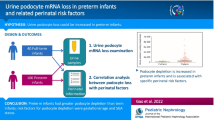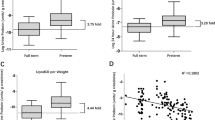Abstract
Background
The number of nephrons at birth is determined during fetal development and is modulated thereafter by postnatal podocyte injury. Hyperfiltration, caused by a reduced number of nephrons, is a risk factor for chronic kidney disease. It is therefore important to monitor the formation of nephrons.
Methods
Urine samples were collected from infants within 1–2 days of birth, with follow-up sampling for preterm infants at 37–39 weeks of corrected age. Urinary levels of podocalyxin (PCX), β2-microglobulin (β2MG), N-acetyl-ß-D-glucosaminidase (NAG), total protein (TP), microalbumin (mAlb) and creatinine were measured and the relationship between these markers evaluated.
Results
Seventy-nine neonates were enrolled in this study. Urinary levels of PCX at birth were higher than normal adult reference values, with levels increasing up to a gestational age of 36 weeks (p = 0.0242). At 37–39 weeks corrected age, urinary levels of PCX decreased to adult levels. The levels of PCX in the urine at birth were not correlated to urinary levels of β2MG, NAG, TP and mAlb.
Conclusions
An increased urinary level of PCX may be a marker of both active nephron formation and podocyte injury sustained at birth. As such, changes in urinary levels of PCX are likely to reflect adaptation of renal function to the extra-uterine environment.




Similar content being viewed by others
References
Carmody JB, Charlton JR (2013) Short-term gestation, long-term risk: prematurity and chronic kidney disease. Pediatrics 131:1168–1179
Barker DJ, Osmond C (1986) Infant mortality, childhood nutrition, and ischaemic heart disease in England and Wales. Lancet 1:1077–1081
Hinchliffe SA, Sargent PH, Howard CV, Chan YF, van Velzen D (1991) Human intrauterine renal growth expressed in absolute number of glomeruli assessed by the disector method and Cavalieri principle. Lab Investig 64:777–784
Hodgin JB, Rasoulpour M, Markowitz GS, D’Agati VD (2009) Very low birth weight is a risk factor for secondary focal segmental glomerulosclerosis. Clin J Am Soc Nephrol 4:71–76
Ikezumi Y, Suzuki T, Karasawa T, Yamada T, Hasegawa H, Nishimura H, Uchiyama M (2013) Low birthweight and premature birth are risk factors for podocytopenia and focal segmental glomerulosclerosis. Am J Nephrol 38:149–157
Vikse BE, Irgens LM, Leivestad T, Hallan S, Iversen BM (2008) Low birth weight increases risk for end-stage renal disease. J Am Soc Nephrol 19:151–157
White SL, Perkovic V, Cass A, Chang CL, Poulter NR, Spector T, Haysom L, Craig JC, Salmi IA, Chadban SJ, Huxley RR (2009) Is low birth weight an antecedent of CKD in later life? A systematic review of observational studies. Am J Kidney Dis 54:248–261
Mundel P, Kriz W (1995) Structure and function of podocytes: an update. Anat Embryol 192:385–397
Mundel P, Shankland SJ (2002) Podocyte biology and response to injury. J Am Soc Nephrol 13:3005–3015
Yu D, Petermann A, Kunter U, Rong S, Shankland SJ, Floege J (2005) Urinary podocyte loss is a more specific marker of ongoing glomerular damage than proteinuria. J Am Soc Nephrol 16:1733–1741
Kent AL, Brown L, Broom M, Broomfield A, Dahlstrom JE (2012) Increased urinary podocytes following indomethacin suggests drug-induced glomerular injury. Pediatr Nephrol 27:1111–1117
Kerjaschki D, Sharkey DJ, Farquhar MG (1984) Identification and characterization of podocalyxin—the major sialoprotein of the renal glomerular epithelial cell. J Cell Biol 98:1591–1596
Nielsen JS, McNagny KM (2009) The role of podocalyxin in health and disease. J Am Soc Nephrol 20:1669–1676
Camici M (2007) Urinary detection of podocyte injury. Biomed Pharmacother 61:245–249
Kanda Y (2013) Investigation of the freely available easy-to-use software ‘EZR’ for medical statistics. Bone Marrow Transplant 48:452–458
Hara M, Yamagata K, Tomino Y, Saito A, Hirayama Y, Ogasawara S, Kurosawa H, Sekine S, Yan K (2012) Urinary podocalyxin is an early marker for podocyte injury in patients with diabetes: establishment of a highly sensitive ELISA to detect urinary podocalyxin. Diabetologia 55:2913–2919
Langhendries JP, Gillain N, Battisti O, Carlier B, Bertrand JM (1987) Normal values for urinary N-acetyl-beta-glucosaminidase excretion in preterm and term babies. Arch Dis Child 62:483–486
Gubhaju L, Sutherland MR, Horne RS, Medhurst A, Kent AL, Ramsden A, Moore L, Singh G, Hoy WE, Black MJ (2014) Assessment of renal functional maturation and injury in preterm neonates during the first month of life. Am J Physiol Ren Physiol 307:F149–F158
Kanwar YS, Wada J, Lin S, Danesh FR, Chugh SS, Yang Q, Banerjee T, Lomasney JW (2004) Update of extracellular matrix, its receptors, and cell adhesion molecules in mammalian nephrogenesis. Am J Physiol Ren Physiol 286:F202–F215
Fernandez D, Larrucea S, Nowakowski A, Pericacho M, Parrilla R, Ayuso MS (2011) Release of podocalyxin into the extracellular space. Role of metalloproteinases. Biochim Biophys Acta 1813:1504–1510
Toth-Heyn P, Drukker A, Guignard JP (2000) The stressed neonatal kidney: from pathophysiology to clinical management of neonatal vasomotor nephropathy. Pediatr Nephrol 14:227–239
El Hamel C, Chianea T, Thon S, Lepichoux A, Yardin C, Guigonis V (2016) Normal values of urine total protein- and albumin-to-creatinine ratios in term newborns. Pediatr Nephrol 32:113–118
Zhou L, Liu Y (2015) Wnt/beta-catenin signalling and podocyte dysfunction in proteinuric kidney disease. Nat Rev Nephrol 11:535–545
Rodriguez MM, Gomez AH, Abitbol CL, Chandar JJ, Duara S, Zilleruelo GE (2004) Histomorphometric analysis of postnatal glomerulogenesis in extremely preterm infants. Pediatr Dev Pathol 7:17–25
Author information
Authors and Affiliations
Corresponding author
Ethics declarations
Ethical approval and consent to participate
The study was approved by the Institutional Ethics Committee at the University of Fukui (# 20140014). Informed consent was obtained from the parents.
Conflict of interest
All authors declare that they do not have any relevant conflict of interests regarding this paper.
Rights and permissions
About this article
Cite this article
Hayashi, T., Tokuriki, S., Okuno, T. et al. Urinary podocalyxin as a possible novel marker of intrauterine nephrogenesis and extrauterine podocyte injury. Pediatr Nephrol 32, 1891–1896 (2017). https://doi.org/10.1007/s00467-017-3676-6
Received:
Revised:
Accepted:
Published:
Issue Date:
DOI: https://doi.org/10.1007/s00467-017-3676-6




